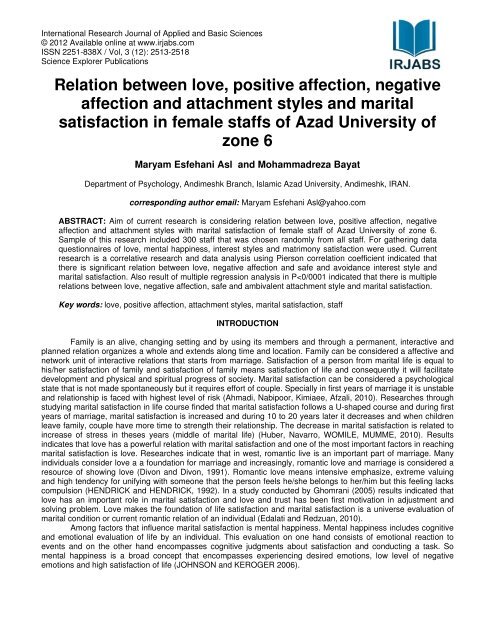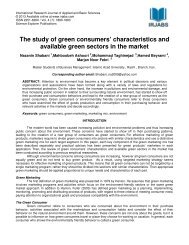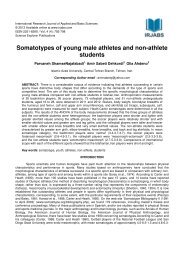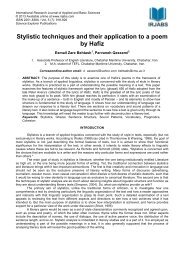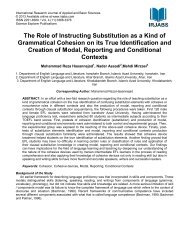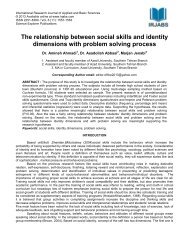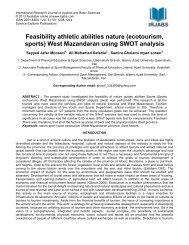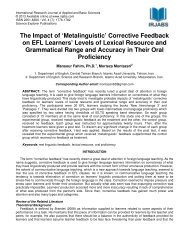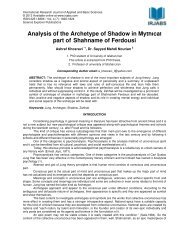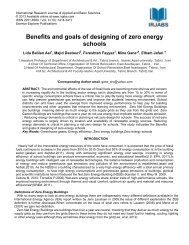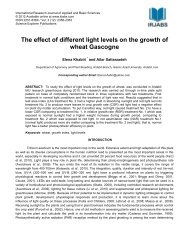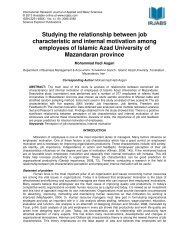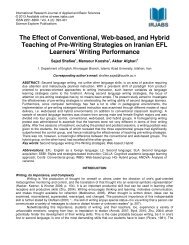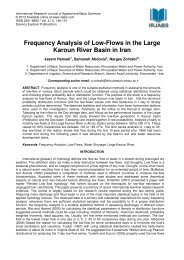Relation between love, positive affection, negative ... - irjabs.com
Relation between love, positive affection, negative ... - irjabs.com
Relation between love, positive affection, negative ... - irjabs.com
You also want an ePaper? Increase the reach of your titles
YUMPU automatically turns print PDFs into web optimized ePapers that Google loves.
International Research Journal of Applied and Basic Sciences<br />
© 2012 Available online at www.<strong>irjabs</strong>.<strong>com</strong><br />
ISSN 2251-838X / Vol, 3 (12): 2513-2518<br />
Science Explorer Publications<br />
<br />
<strong>Relation</strong> <strong>between</strong> <strong>love</strong>, <strong>positive</strong> <strong>affection</strong>, <strong>negative</strong><br />
<strong>affection</strong> and attachment styles and marital<br />
satisfaction in female staffs of Azad University of<br />
zone 6<br />
Maryam Esfehani Asl and Mohammadreza Bayat<br />
Department of Psychology, Andimeshk Branch, Islamic Azad University, Andimeshk, IRAN.<br />
corresponding author email: Maryam Esfehani Asl@yahoo.<strong>com</strong><br />
ABSTRACT: Aim of current research is considering relation <strong>between</strong> <strong>love</strong>, <strong>positive</strong> <strong>affection</strong>, <strong>negative</strong><br />
<strong>affection</strong> and attachment styles with marital satisfaction of female staff of Azad University of zone 6.<br />
Sample of this research included 300 staff that was chosen randomly from all staff. For gathering data<br />
questionnaires of <strong>love</strong>, mental happiness, interest styles and matrimony satisfaction were used. Current<br />
research is a correlative research and data analysis using Pierson correlation coefficient indicated that<br />
there is significant relation <strong>between</strong> <strong>love</strong>, <strong>negative</strong> <strong>affection</strong> and safe and avoidance interest style and<br />
marital satisfaction. Also result of multiple regression analysis in P
Intl. Res. J. Appl. Basic. Sci. Vol., 3 (12), 2513-2518, 2012<br />
<br />
In a research, chelbianlo (2004) considered relation <strong>between</strong> mental happiness and marital satisfaction. In<br />
this research 41 couples were considered by Panas mental happiness questionnaire and Enrich marital satisfaction<br />
questionair. Results of regression analysis indicate that among mental happiness dimensions, two dimensions of<br />
life satisfaction were predicted <strong>positive</strong>ly and <strong>negative</strong> <strong>affection</strong> was predicted <strong>negative</strong>ly by marital satisfaction.<br />
Attachment styles is another effective factor of marital satisfaction. Attachment includes a relative stable<br />
emotional affective relation that is made <strong>between</strong> child and mother or individuals who have regular and permanent<br />
interaction with child (Papila, 2003. Then Bowilby). Papila considered attachment from developmental viewpoint<br />
and founded his theory on this basis that feelings and attachment behaviours including crying and smiling<br />
approximate the child to mother and keeps him/her away from risk. Real experiences of a person about<br />
sensitiveness, responsiveness, active attendance of caregiver as well as child’s temperament and cooperation of<br />
child-parent relation is the foundation of shaping different attachment styles during childhood (Kaplan, 2000).<br />
Experiences that the child has with his/ her caregiver is internalized in patterns of her/his relation with<br />
others and this internalized practical pattern is determinant of understanding of child about himself and others.<br />
This understanding is repaired later in interaction with others (Pinez, 2005). Among most popular researches in this<br />
context are researches of Hazen and Shaver (quoted by Pinez, 2005) and Inzorth (quoted by Pinez, 2005) that<br />
considered mutual attachments of adults in couples relation.<br />
Results indicated that traits of affective relation <strong>between</strong> couples is <strong>com</strong>parable with traits of affective<br />
relation of child and mother and recognized styles such as safe, avoidant and ambivalent attachment styles<br />
influence feelings and behaviours of couples. Among conducted researches in this context we can refer to<br />
researches of Besharat, 2001, Sharifi and Irvani, 2001, Golinezhad and Ahmadi, 2002, Asgharinezhad and<br />
Danesh, 2005) that all indicate this issue that testees with safe attachment style have ambivalent avoidant marital<br />
problems. Given to important role of <strong>love</strong>, <strong>positive</strong> <strong>affection</strong>, <strong>negative</strong> <strong>affection</strong> and attachment styles in marital<br />
relations and its effect on amount of marital relation, current research aims to consider these variables and<br />
answering to this question that is there any relation <strong>between</strong> <strong>love</strong>, <strong>positive</strong> <strong>affection</strong>, <strong>negative</strong> <strong>affection</strong> and<br />
attachment styles and marital satisfaction of female staff of Azad university of zone 6?<br />
First hypothesis: there is relation <strong>between</strong> <strong>love</strong> and marital satisfaction<br />
Second hypothesis: there is relation <strong>between</strong> <strong>positive</strong> <strong>affection</strong> and marital satisfaction.<br />
Third hypothesis: there is relation <strong>between</strong> <strong>negative</strong> <strong>affection</strong> and marital satisfaction.<br />
Fourth hypothesis: there is relation <strong>between</strong> safe attachment style and marital satisfaction.<br />
Fifth hypothesis: there is relation <strong>between</strong> avoidant attachment style and marital satisfaction.<br />
Sixth hypothesis: there is relation <strong>between</strong> ambivalent attachment style and marital satisfaction.<br />
Seventh hypothesis: there are multiple relations <strong>between</strong> <strong>love</strong>, <strong>positive</strong> <strong>affection</strong>, <strong>negative</strong> <strong>affection</strong> and attachment<br />
styles with marital satisfaction.<br />
RESEARCH METHOD<br />
Statistical universe of this research included all female staff of Azad university of zone 6. 300 individuals<br />
were chosen randomly given to Morgan table and participated in research.<br />
Research tools<br />
Love questionnaire<br />
This scale was provided by Sterenberg in north eastern Boston university. It includes 45 questions and has<br />
three subscales (<strong>com</strong>mitment, lust and sincerity). Bakhshande (2002) considered validity and reliability of this<br />
questionnaire. For considering validity of this questionnaire, questionnaire of criterion of relation with self and<br />
others was used.<br />
Obtained validity coefficient was (N=100, R=0/43, P
Intl. Res. J. Appl. Basic. Sci. Vol., 3 (12), 2513-2518, 2012<br />
<br />
questionnaire was considered by Matlabzade (2007). For determining criterion validity of this questionnaire life<br />
satisfaction questionnaire was used and it was calculated to be 0/27 for <strong>positive</strong> <strong>affection</strong> and -0/27 for <strong>negative</strong><br />
<strong>affection</strong> (all in significance level of 0/01). Reliability of this questionnaire was calculated by Crunbak Alfa method<br />
that was equal to 0/85 that indicates desired reliability of questionnaire. In current research obtained reliability<br />
coefficients by Crunbak and Tansif method are 0/84 and 0/74 respectively.<br />
Questionnaire of attachment styles<br />
This questionnaire is made by Simpesin(1990). This test includes 13 items. 5 of 13 items are for evaluating<br />
safe attachment and 8 are for evaluating ambivalent and avoidant attachment styles. Abasi Sarcheshme (2005)<br />
obtained validity of test. Questions were correlated with scores of attachment styles. Its correlation coefficient was<br />
0/59 which was significant in R
Intl. Res. J. Appl. Basic. Sci. Vol., 3 (12), 2513-2518, 2012<br />
<br />
Second hypothesis: there is relation <strong>between</strong> <strong>positive</strong> <strong>affection</strong> and marital satisfaction. As it is shown in<br />
table 2, there is <strong>positive</strong> significant relation <strong>between</strong> <strong>positive</strong> <strong>affection</strong> and marital satisfaction. So second<br />
hypothesis is approved(N=300, P
Intl. Res. J. Appl. Basic. Sci. Vol., 3 (12), 2513-2518, 2012<br />
<br />
sexual aspects, includes ability of individual for accepting <strong>com</strong>mitment toward others. Sometimes this <strong>com</strong>mitment<br />
requires sacrificing. This kind of <strong>love</strong> be<strong>com</strong>es apparent when someone is deeply capable of being in <strong>love</strong>, respect<br />
others, care about others and accept responsibility of others. So a person in <strong>love</strong> can sacrifice that it leads to<br />
success in marriage (Abdolmaleki, 2008). Love as an important factor can lead to marital satisfaction and stabilize<br />
marital relation. Marital satisfaction is a universal evaluation of marital relation or romantic relation of an individual<br />
(Ghomrani, 2005). On the other hand, in the current research it was shown that there is <strong>negative</strong> relation <strong>between</strong><br />
<strong>negative</strong> <strong>affection</strong> and marital satisfaction. But there is <strong>positive</strong> relation <strong>between</strong> <strong>positive</strong> <strong>affection</strong> and marital<br />
satisfaction. Results of this hypothesis is <strong>com</strong>patible with findings of Johnson and Keroger (2006), Chalbiano<br />
(2007), Matlabzade (2007). Mental happiness is a broad concept that en<strong>com</strong>passes experiencing desired<br />
emotions, low levels of <strong>negative</strong> emotion and high level of life satisfaction (Johnson and Keroger, 2006). Mental<br />
happiness is reflected in criteria and evaluation of people about life in cognitive aspects, psychological function and<br />
social functions and mental happiness in relatively stable in life span and is influenced by primary environment.<br />
What determines mental happiness is a desired environment in family and existence of <strong>com</strong>mon life of parents as<br />
well as their marital satisfaction. Mental happiness has three <strong>com</strong>ponents that include life satisfaction, <strong>positive</strong><br />
<strong>affection</strong> and <strong>negative</strong> <strong>affection</strong>. Each <strong>com</strong>ponent is divided into sub<strong>com</strong>ponents. For example satisfaction includes<br />
<strong>love</strong>, marriage, etc and <strong>positive</strong> <strong>affection</strong> includes pleasure, <strong>love</strong>, etc and <strong>negative</strong> <strong>affection</strong> includes guilty,<br />
embarrass, etc. as <strong>positive</strong> <strong>affection</strong> decreases and <strong>negative</strong> <strong>affection</strong> increases, couples be<strong>com</strong>e more unsatisfied<br />
and vice versa. So <strong>positive</strong> <strong>affection</strong> is <strong>positive</strong> feelings and will increase life satisfaction and <strong>negative</strong> <strong>affection</strong> is<br />
<strong>negative</strong> feelings and has an <strong>negative</strong> influence on marital satisfaction.<br />
Also according to results of current research, there is <strong>positive</strong> significant relation <strong>between</strong> safe attachment<br />
and marital satisfaction but there is <strong>negative</strong> significant relation <strong>between</strong> ambivalent and avoidant attachment and<br />
marital satisfaction. This result is <strong>com</strong>patible with results of Besharat(2001), Inzoreth (1991), Hazen and Shaver<br />
(1987, quoted by Kaplan), Cob, Davila, Bradbory (2001), Pinez (2005), Besharat (2001), Besharat, Sharifi and<br />
Irvani (2001), Besharat, Golinejad and Ahmadi (2002). Self confidence and trust toward others is an internal<br />
psychological trait of someone who has safe attachment and helps the individual in getting help from others. Also<br />
in marital life these people, through healthy and normal relation with their spouse, provide condition for pleasurable<br />
life (Besharat, 2001). Positive understanding and social support are other traits of a person with safe attachment<br />
style that can explain aforementioned findings. Positive understanding of spouse strength supportive interactions of<br />
them and it can lead to marital satisfaction (Pinez, 2005). Ability of problem solving in these individuals is a result of<br />
normal discovery.<br />
It is re<strong>com</strong>mended that young adults who are going to marry participate in workshops that are held for<br />
instructing skills of expressing <strong>love</strong>, etc. it is re<strong>com</strong>mended that solutions for preventing and treating in frame of<br />
attachment theory be used. It is re<strong>com</strong>mended that in counseling session before marriage attachment style and<br />
amount of <strong>love</strong> and evaluation of life by couple be considered because it can affect choosing spouse and<br />
preventing divorce.<br />
REFERENCES<br />
Abasi Sarcheshme A. 2005. Considering simple and multiple relation of optimistic religious attitude and attachment styles and marital<br />
satisfaction in male students of Ahvaz university, master thesis, Ahvaz shahid chamran university.<br />
Abdolmaleki S. 2008. Mental health magazine, no 26, winter 2008.<br />
Ahmadi K, Nabipor SM, Kimiaee SA, Afzali MH. 2010. Effect of family problem problem soving on martial satisfaction. Journal of applied<br />
science. 1.(8) 682-687<br />
Bakhshande S. 2002. Considering <strong>love</strong> and marital satisfaction in female students, master tesis, Ahvaz Azad University<br />
Behsarat M. 2001. Considering relation <strong>between</strong> attachment styles and marital problems in sterile couples, magazine of psychological news, 55-<br />
66, 19,20<br />
Besharat M, Golinejad M, Ahmadi A. 2002. Considering relation <strong>between</strong> attachment style and interpersonal problems of students, Tehran<br />
university, adopted from (URL: www.irnpa.org.-12/5/2006)<br />
Besharat M, Sharifi M, Irvani M. 2001. Considering attachment styles and defensive mechanism, psychological magazine, 19(3), 277-289<br />
Chalbianloo Gh. 2004. Considering the relation <strong>between</strong> mental happiness and marital satisfaction, master thesis, Shiraz Azad University<br />
Cobb RI, Davila J, Bradbury TN. 2001. Attachment security and marital satisfaction : the role of <strong>positive</strong> perception and social support.<br />
Personality and social psychology, 27, 1131-1143.<br />
Divon KL, Divon KK. 1991. Psychological individualism and romantic <strong>love</strong>, journal of social behavior and personality, 6.11-33.<br />
Edalati A, Redzuaun M. 2010. Perception of women towards family values and their mari-tal satis faction. Journal of American science 6(4):<br />
132-137.<br />
Fisher HE. 2006. The drive to <strong>love</strong>. in. rsternbery & k. weis(eds), the new psychology of <strong>love</strong> (pp.87-115) new haven : yale university press.<br />
Ghomrani A. 2005. Considering romantic relation of Iranian couples and its relation with marital satisfaction and demographic variables/ master<br />
thesis, Tehran shahed university.<br />
Hendrick SS, Hendrick C. 1992. Romantic <strong>love</strong>, new bury park, ca: sage.<br />
Huber CH, Mnavaro RL, Womble MW, Mumme FI. 2010. Family resilience and midlife martial satisfaction. The familt journal: counseling and<br />
therapy for coples and families.33vol: 347-456 -1.
Intl. Res. J. Appl. Basic. Sci. Vol., 3 (12), 2513-2518, 2012<br />
<br />
Johson W, Krueger RF. 2006. How money buys happiness: genetic and envir mental pro-cesses linking finances and life satisfaction . Journal<br />
of personality and social psychology, 9. (4): 680-691.<br />
Kaplan P. 2000. Developmental psychology/ translated by Mehrdad Firooz (2005)/ Tehran: Rasa (publishing date in main language, 2000).<br />
Karimi Y. 2001. Personality psychology, seventh edition, Virayesh press<br />
Karin William C. 2005. Development theories, concepts and applications/ translated by Gholamreza Khuinejad and Alireza Khuinejad and<br />
Alireza Rajaee, Tehran Roshd<br />
Matlabzade A. 2007. Considering influence of humor on mental health and mental happiness in Shiraz students, master thesis, Shiraz<br />
University<br />
Papilla DE. 2002. A child’s world: infancy through adolescence. New york: mcg raw-hill.<br />
Pines A. 2005. Falling in <strong>love</strong> (why we choose the <strong>love</strong>s we choose). New York and hove: Rutledge.<br />
Sanaee H. 2000. Scales of family and marriage evaluation, Tehran Roshd press.<br />
Simpson JA. 1990. Attachment and the experience and ekpression of emotions in romantic rela-tion ship. Journal of personality and social<br />
psychology 92,355-367.<br />
Soleimanian A. 1994. Considering influence of illogical thinking on marital dissatisfaction according to cognitive approach, master thesis, Tehran<br />
University<br />
Wason D, Clark LAR, Tellegren A. 1988. Development and validation of brief measures of <strong>positive</strong> and <strong>negative</strong> affect: the panas . scales.<br />
Journal of personality & social psychology. 54. 1063-1169.


